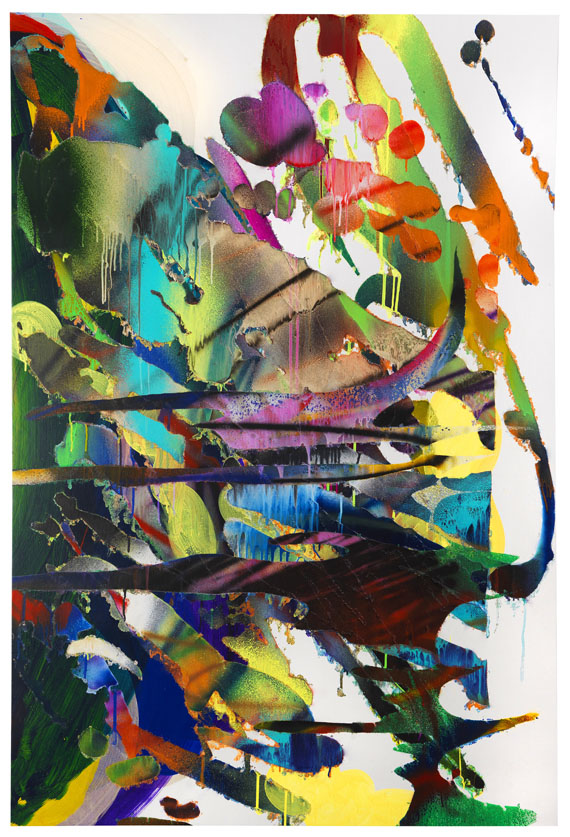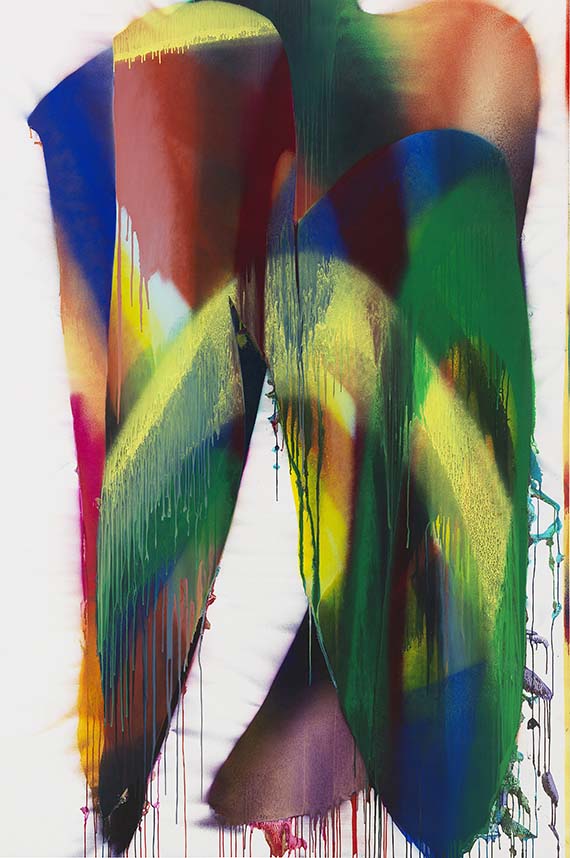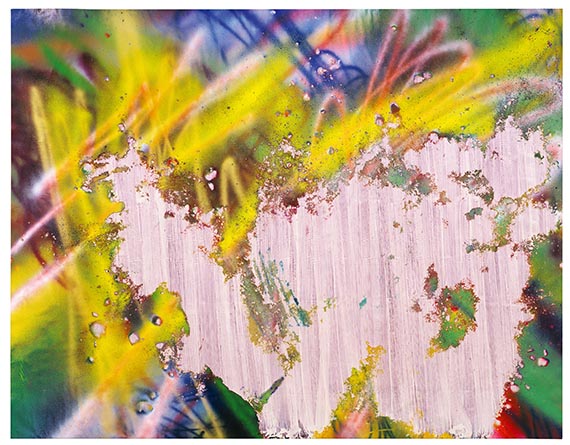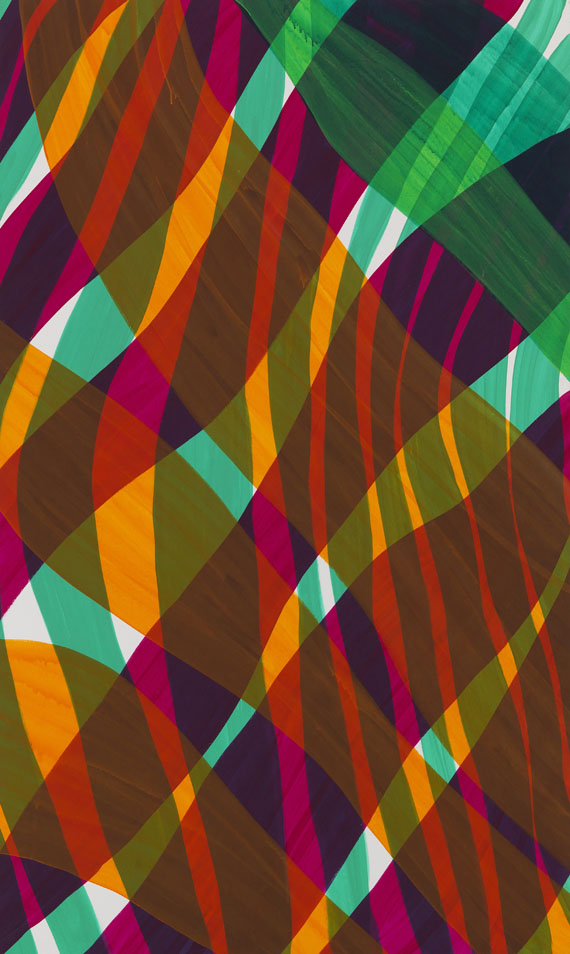26
Katharina Grosse
Ohne Titel, 2009.
Soil and Acrylic on canvas
Estimate:
€ 150,000 - 250,000
$ 165,000 - 275,000
Ohne Titel. 2009.
Soil and Acrylic on canvas.
Signed and inscribed with the work number "2009/1027 L" and two direction arrows on the reverse. Approved by the artist for both portrait and landscape display. 258.6 x 394.5 cm (101.8 x 155.3 in).
[KT].
•Well-thought-out complexity: Using soil makes for a nuanced and progressive composition.
• Relief-like structures create a distinctive haptic component and a fascinating depth effect.
• Grosse's monumental works are expansive color sensations.
• Her works are part of the most renowned international collections: the Kunsthaus Zürich, the Städtische Galerie im Lenbachhaus, Munich, and the Centre Pompidou.
• Grosse has recently been honored with spectacular solo exhibitions at the Hamburger Bahnhof, Berlin (2020/21) and the Albertina in Vienna (2023/24). Until September 2024, the Kunstmuseum Bonn presented the retrospective “Katharina Grosse. Studio Paintings 1988-2023,” which had previously been on display in Switzerland and the USA.
We are grateful to the Studio Katharina Grosse, Berlin, for the kind support in cataloging this lot.
PROVENANCE: Galerie nächst St. Stephan Rosemarie Schwarzwälder, Vienna.
Private collection, Southern Germany (acquired from the above in 2009).
EXHIBITION: Generations Part I. Künstlerinnen im Dialog, Goetz Collection, Munich, February 22 - June 30, 2018.
LITERATURE: Ingvild Goetz, Leo Lencsés, Karsten Löckemann (ed.), Generations - Künstlerinnen im Dialog Part I, II, III, Berlin 2019, illustrated on pp. 57 and 208.
Called up: December 6, 2024 - ca. 17.50 h +/- 20 min.
Soil and Acrylic on canvas.
Signed and inscribed with the work number "2009/1027 L" and two direction arrows on the reverse. Approved by the artist for both portrait and landscape display. 258.6 x 394.5 cm (101.8 x 155.3 in).
[KT].
•Well-thought-out complexity: Using soil makes for a nuanced and progressive composition.
• Relief-like structures create a distinctive haptic component and a fascinating depth effect.
• Grosse's monumental works are expansive color sensations.
• Her works are part of the most renowned international collections: the Kunsthaus Zürich, the Städtische Galerie im Lenbachhaus, Munich, and the Centre Pompidou.
• Grosse has recently been honored with spectacular solo exhibitions at the Hamburger Bahnhof, Berlin (2020/21) and the Albertina in Vienna (2023/24). Until September 2024, the Kunstmuseum Bonn presented the retrospective “Katharina Grosse. Studio Paintings 1988-2023,” which had previously been on display in Switzerland and the USA.
We are grateful to the Studio Katharina Grosse, Berlin, for the kind support in cataloging this lot.
PROVENANCE: Galerie nächst St. Stephan Rosemarie Schwarzwälder, Vienna.
Private collection, Southern Germany (acquired from the above in 2009).
EXHIBITION: Generations Part I. Künstlerinnen im Dialog, Goetz Collection, Munich, February 22 - June 30, 2018.
LITERATURE: Ingvild Goetz, Leo Lencsés, Karsten Löckemann (ed.), Generations - Künstlerinnen im Dialog Part I, II, III, Berlin 2019, illustrated on pp. 57 and 208.
Called up: December 6, 2024 - ca. 17.50 h +/- 20 min.
Katharina Grosse is a leading light in the international contemporary art scene. Her works transcend the traditional boundaries of painting, expanding them into three-dimensional space. “Color is something very intimate. It evokes immediate reactions,” explains the artist, offering a glimpse into her creative process, which often takes on a performative character. She combines unmixed industrial paints to create multi-layered, polychrome compositions in her works. As a result, she creates optical patterns using stencils, cracks, and cuts that radically challenge traditional perceptions of painting. The dynamic application of the paint is a central element of her art, which often expands to include surfaces such as walls, floors, or even exterior facades. This structural openness gives her work an immersive dimension that draws viewers into the color space where the boundary between art and the surrounding environment dissolves.
Alongside spray painting, for which Grosse uses a spray gun as her most distinctive tool, the artist also experiments with natural materials such as soil - an organic element that adds an unpredictable, almost anarchic element to her work. A deliberate choice that allows her to juxtapose the technical precision of the industrial paints with natural textures. Soil as a material carries a physical and metaphorical heaviness that lends Grosse's work an additional dimension and intensifies her artistic engagement with nature. Since the 1990s, Grosse has explored new ways of applying paint. Particularly noteworthy is her use of color as a sculptural element. Whether applied in a glazing manner, in dense, crusty layers or almost transparently like mist, the various textures and aggregate states of color are at the center of her art. At the 1998 Sydney Biennale, Grosse sprayed directly onto architectural structures for the first time, a moment considered a milestone in her artistic development. She later expanded on this technique, for example, in her spectacular installation at the Hamburger Bahnhof in Berlin in 2020/21, where she let layers of color crawl across three-dimensional polystyrene structures, thus connecting the interior and exterior spaces. At this point, her proximity to graffiti art became particularly apparent: the sprayed paint, covering structures with lines and surfaces, is strongly reminiscent of acts of youthful rebellion and the expression of this urban art form. In some of her recent works, Grosse has created a three-dimensional effect by applying sand to the canvas, which she mixed with color pigments. A method that leads to color blocks that seemingly float above a dynamic network of lines. This approach indicates her unusual combination of color and material and her expansion of the pictorial space into new dimensions. The interplay of industrial colors and natural materials such as soil and sand also gives Grosses' large-scale works an uncontrollable, raw energy. This balance between chaos and control, between nature and technology, characterizes Katharina Grosse's art and makes each of her works a complex and dynamic visual experience. [KT]
Alongside spray painting, for which Grosse uses a spray gun as her most distinctive tool, the artist also experiments with natural materials such as soil - an organic element that adds an unpredictable, almost anarchic element to her work. A deliberate choice that allows her to juxtapose the technical precision of the industrial paints with natural textures. Soil as a material carries a physical and metaphorical heaviness that lends Grosse's work an additional dimension and intensifies her artistic engagement with nature. Since the 1990s, Grosse has explored new ways of applying paint. Particularly noteworthy is her use of color as a sculptural element. Whether applied in a glazing manner, in dense, crusty layers or almost transparently like mist, the various textures and aggregate states of color are at the center of her art. At the 1998 Sydney Biennale, Grosse sprayed directly onto architectural structures for the first time, a moment considered a milestone in her artistic development. She later expanded on this technique, for example, in her spectacular installation at the Hamburger Bahnhof in Berlin in 2020/21, where she let layers of color crawl across three-dimensional polystyrene structures, thus connecting the interior and exterior spaces. At this point, her proximity to graffiti art became particularly apparent: the sprayed paint, covering structures with lines and surfaces, is strongly reminiscent of acts of youthful rebellion and the expression of this urban art form. In some of her recent works, Grosse has created a three-dimensional effect by applying sand to the canvas, which she mixed with color pigments. A method that leads to color blocks that seemingly float above a dynamic network of lines. This approach indicates her unusual combination of color and material and her expansion of the pictorial space into new dimensions. The interplay of industrial colors and natural materials such as soil and sand also gives Grosses' large-scale works an uncontrollable, raw energy. This balance between chaos and control, between nature and technology, characterizes Katharina Grosse's art and makes each of her works a complex and dynamic visual experience. [KT]
26
Katharina Grosse
Ohne Titel, 2009.
Soil and Acrylic on canvas
Estimate:
€ 150,000 - 250,000
$ 165,000 - 275,000
Buyer's premium, taxation and resale right compensation for Katharina Grosse "Ohne Titel"
This lot can be purchased subject to differential or regular taxation, artist‘s resale right compensation is due.
Differential taxation:
Hammer price up to 800,000 €: herefrom 32 % premium.
The share of the hammer price exceeding 800,000 € is subject to a premium of 27 % and is added to the premium of the share of the hammer price up to 800,000 €.
The share of the hammer price exceeding 4,000,000 € is subject to a premium of 22 % and is added to the premium of the share of the hammer price up to 4,000,000 €.
The buyer's premium contains VAT, however, it is not shown.
Regular taxation:
Hammer price up to 800,000 €: herefrom 27 % premium.
The share of the hammer price exceeding 800,000 € is subject to a premium of 21% and is added to the premium of the share of the hammer price up to 800,000 €.
The share of the hammer price exceeding 4,000,000 € is subject to a premium of 15% and is added to the premium of the share of the hammer price up to 4,000,000 €.
The statutory VAT of currently 19 % is levied to the sum of hammer price and premium. As an exception, the reduced VAT of 7 % is added for printed books.
We kindly ask you to notify us before invoicing if you wish to be subject to regular taxation.
Calculation of artist‘s resale right compensation:
For works by living artists, or by artists who died less than 70 years ago, a artist‘s resale right compensation is levied in accordance with Section 26 UrhG:
4 % of hammer price from 400.00 euros up to 50,000 euros,
another 3 % of the hammer price from 50,000.01 to 200,000 euros,
another 1 % for the part of the sales proceeds from 200,000.01 to 350,000 euros,
another 0.5 % for the part of the sale proceeds from 350,000.01 to 500,000 euros and
another 0.25 % of the hammer price over 500,000 euros.
The maximum total of the resale right fee is EUR 12,500.
The artist‘s resale right compensation is VAT-exempt.
Differential taxation:
Hammer price up to 800,000 €: herefrom 32 % premium.
The share of the hammer price exceeding 800,000 € is subject to a premium of 27 % and is added to the premium of the share of the hammer price up to 800,000 €.
The share of the hammer price exceeding 4,000,000 € is subject to a premium of 22 % and is added to the premium of the share of the hammer price up to 4,000,000 €.
The buyer's premium contains VAT, however, it is not shown.
Regular taxation:
Hammer price up to 800,000 €: herefrom 27 % premium.
The share of the hammer price exceeding 800,000 € is subject to a premium of 21% and is added to the premium of the share of the hammer price up to 800,000 €.
The share of the hammer price exceeding 4,000,000 € is subject to a premium of 15% and is added to the premium of the share of the hammer price up to 4,000,000 €.
The statutory VAT of currently 19 % is levied to the sum of hammer price and premium. As an exception, the reduced VAT of 7 % is added for printed books.
We kindly ask you to notify us before invoicing if you wish to be subject to regular taxation.
Calculation of artist‘s resale right compensation:
For works by living artists, or by artists who died less than 70 years ago, a artist‘s resale right compensation is levied in accordance with Section 26 UrhG:
4 % of hammer price from 400.00 euros up to 50,000 euros,
another 3 % of the hammer price from 50,000.01 to 200,000 euros,
another 1 % for the part of the sales proceeds from 200,000.01 to 350,000 euros,
another 0.5 % for the part of the sale proceeds from 350,000.01 to 500,000 euros and
another 0.25 % of the hammer price over 500,000 euros.
The maximum total of the resale right fee is EUR 12,500.
The artist‘s resale right compensation is VAT-exempt.




 Lot 26
Lot 26 






